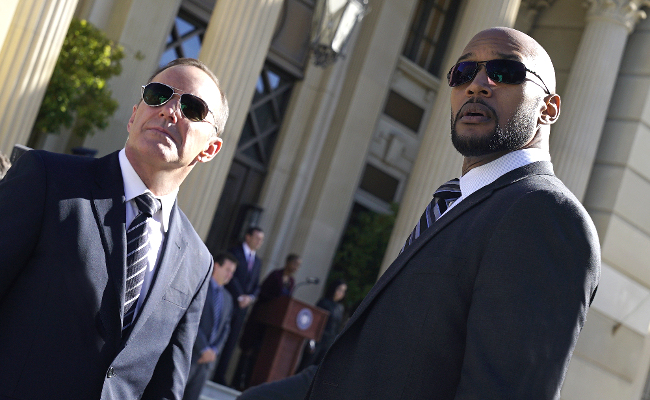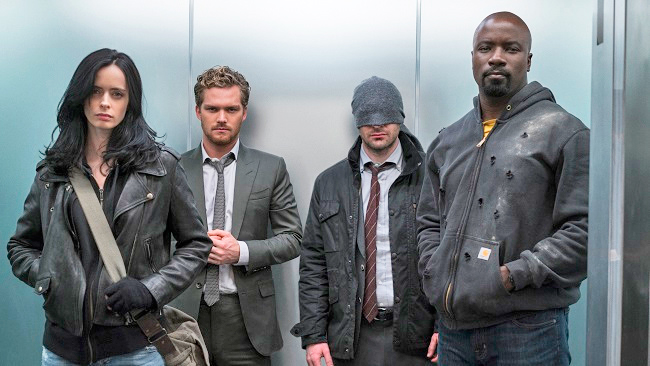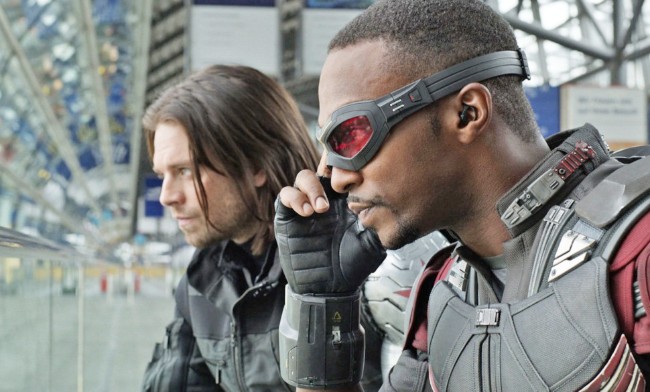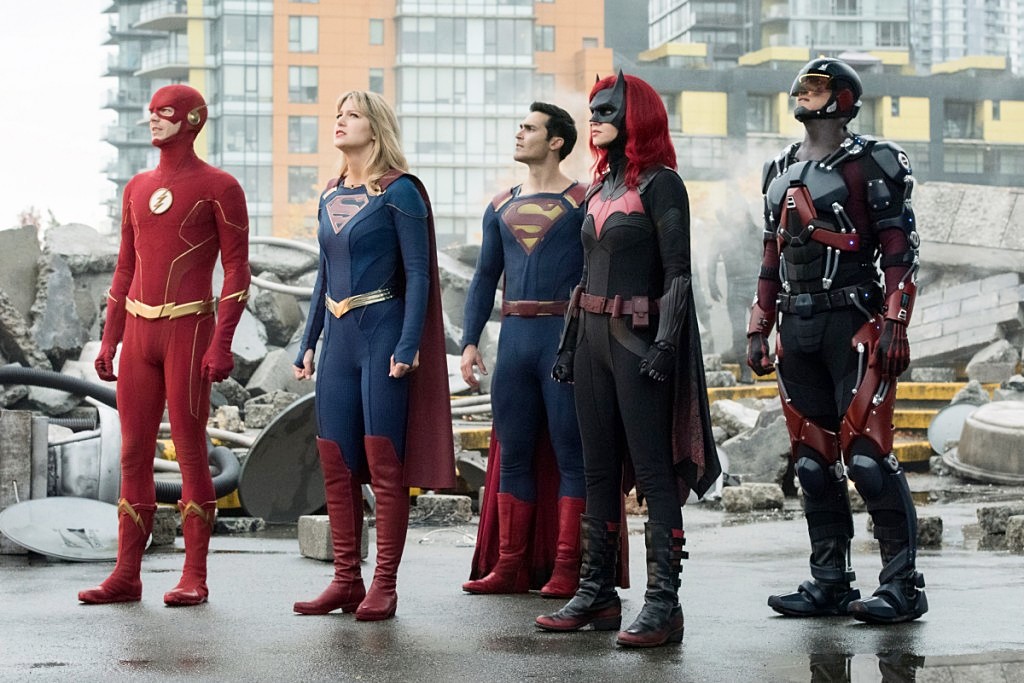Just as superheroes have dominated the box office over the past decade, caped crusaders and masked vigilantes have also invaded a TV landscape that’s only getting more and more crowded. There have been hooded billionaires who patrol the streets at night armed with a bow and arrow; enhanced crime scene investigators who give chase at the speed of light; blind attorneys who double as hellish saviors; invincible heroes who hail from Harlem; aliens from faraway planets; and a boozy private eye.
For a while, these justice-seekers seemed poised to take over our small screens, riding a wave of superhero mania and wielding it to carve out a particular niche during the era of Peak TV, when hundreds of new shows competed for eyes each year and vanished just as quickly as they arrived. A few managed to survive the ratings cull. Shows like Arrow and The Flash have steadily performed for the CW, and Netflix had a lucrative deal with Marvel to bring their street hero gang to life for streaming subscribers.
But the arrival of more streaming services, like Disney+, DC Universe, and the upcoming HBO Max, seem to have disrupted plans for new seasons of shows like Daredevil, The Punisher and made viewing superhero dramas on the CW more difficult. The streaming wars have also claimed YA superhero casualties like Hulu’s Marvel’s Runaways and Freeform’s Cloak & Dagger.
For fans of these small-screen avengers, it can be confusing and concerning to watch the different streaming platforms battle it out over rights to beloved characters and storylines, ones that play better over the course of a multiple-season series rather than on the big screen thanks to their ability to dive into multiple universes and plot out various arcs with the promise of more time.
But we’re simplifying the timeline, digging into the past and the uncertain future of some of TV’s most promising comic book adaptations to see where (and how) they might find new life. Let’s get started, starting with Marvel and moving to DC and beyond.

Agents of S.H.I.E.L.D.
ABC’s Agents of Shield helped launch our current comic book TV craze back in 2013 when it premiered on the Disney owned network. Sporting a familiar character in Gregg Clark’s fan-favorite Agent Coulson, who was resurrected following the events of Marvel’s Avengers to lead a team of agents working on behalf of S.H.I.E.L.D., the show was created by Avengers director Joss Whedon and was directly influenced by events in Marvel films like Captain America: The Winter Soldier, Avengers: Age of Ultron, and Captain America: Civil War. But those tie-ins ended up hurting the show in the long run, with viewership drastically declining and writers beholden to bridging events happening on the big screen. Despite being a hit with critics and on social media, the show is set to end in its seventh season with planned spin-offs axed and fellow Marvel/ABC pairings like Agent Carter and Inhumans already in the grave, marking the end of an era for ABC’s superhero programming.

Netflix’s Marvel Universe
While Agents of Shield’s episode arcs often mirrored events in Marvel’s blockbuster universe, Netflix’s programming aimed to focus on street-level heroes, mining the IP of familiar characters like Daredevil and Jessica Jones, and keeping their origin stories contained to places like Hell’s Kitchen. Daredevil kicked things off by delivering a scrappy, morally-conflicted Matt Murdock (Charlie Cox) and weaving his story of a blind attorney whose busy nightlife includes using his enhanced abilities to fight crime into the tales of other city saviors like Jessica Jones (Krysten Ritter) and Luke Cage (Mike Colter). While Daredevil’s second and third seasons strengthened the character’s arc, introducing fans to Jon Bernthal’s The Punisher and Vincent D’Onofrio’s Kingpin, Jones and Cage didn’t fare as well, with followup seasons that weren’t critical hits. Add to that the dismal performance of Iron Fist and the convoluted storyline of The Defenders, a team-up event expected to perform big for the platform, and the split between Marvel and Netflix felt like a sure thing. With the plan to host new comic book series centering on stars from the studio’s film series on Disney’s service, the future of Marvel’s street heroes seems pretty bleak, a shame considering how nuanced Cox’s portrayal of Murdock was and how badass Ritter’s messy private detective ended up being.

Disney+ Spinoffs
Speaking of the theatrical Marvel Universe, it seems that Phase Four of the plan will include a crop of new series starring familiar heroes from the films. If Marvel’s track record of attempting to expand its universe through minor characters on network TV and competing streaming platforms has been less than stellar, perhaps building on the star power of Anthony Mackie, Sebastian Stan, Tom Hiddleston, and Elizabeth Olsen will be the winning formula. With The Falcon and The Winter Soldier, Loki, and WandaVision all set to drop in the next couple of years, Disney+ has the ability to draw in fans of the films by offering neater endings for characters whose storylines may have been sacrificed in service of Endgame’s larger plan. Mackie and Stan will pick up with their heroes right after the events of the final film, while Hiddleston will play a past-version of Loki fans met in Endgame, and Olsen will imagine a trippy new life for her character and Paul Bettany’s Vision that should tie into Doctor Strange and the Multiverse of Madness.
Each of these shows are pegged as limited series, which means unlike S.H.I.E.L.D. or the Netflix projects, they’ll more than likely end after just a handful of episodes, to better free up their talent and ensure the shared timeline of the film series and TV projects doesn’t get too messy. Still, the idea that Disney+ can take advantage of access to these characters and actors, offering contained series that wrap up storylines and continue to feed excitement for future films is good news — for the studio and for fans. It means we’re promised shows like She-Hulk, Moon Knight, Mrs. Marvel, and What If …? at some point down the pipeline, characters that might have only warranted a supporting role on the big screen who now get to flesh out their stories in increments of six to ten episodes.

The CW and the DC Universe Streaming Service
Most of the talk around comic book television centers on Marvel’s efforts to extend the life of its most popular characters, and that’s because the Marvel Universe on film has outperformed its DC counterpart. While Kevin Feige has been webbing together multiple timelines and characters and faraway galaxies, merging entire teams of superheroes while also crafting solo origin stories to set up new phases, DC has struggled to find success with just a few mainstays. Gal Gadot’s Wonder Woman has been a big performer for the studio, with a sequel directed once again by Patty Jenkins coming early next year. Jason Momoa’s Aquaman also did well at the box office, warranting more stories of the underwater maverick. But films like Batman v Superman: Dawn of Justice (which attempted to pit fan-favorite characters Superman (Henry Cavill) and Batman (Ben Affleck) against one another) and Justice League (which tried to recreate the feel of an Avengers team-up but was bogged down by baffling plots and a mediocre villain) have fallen short and left the studio struggling to build anything intricate and self-sustaining out of its properties.
In that sense, the CW’s command of DC’s lower level heroes has been the studio’s saving grace. Arrow (which sees Stephen Amell playing a billionaire-playboy-turned-crime-fighting-robin-hood) is one of the networks longest-running, best-performing series. And the show has spawned an entire shared universe of DC characters, with The Flash focusing on Barry Allen (Grant Gustin) and his lab of justice dealers and DC’s Legends of Tomorrow, a show about a time-traveling group of vigilantes who often cross paths with Arrow and The Flash. The transition of CBS’ Supergirl to the network has only strengthened its roster of superheroes, with Kara Zor-El’s (Melissa Benoist) exploits in National City often entwining into the greater Arrowverse.
What the CW has been able to do on TV, what DC hasn’t yet figured out on the big screen, is how to have multiple heroes and stories existing in alternate timelines. In the CW’s superhero world, Arrow, The Flash, and the D-list heroes of Legends of Tomorrow all exist on Earth-1. Legends often time travels, but they share a home base in the same verse as Barry Allen and Oliver Queen. Supergirl lives on Earth-38, an Earth in a parallel universe (because those first three shows don’t have Superman in their world, hence why they can operate outside of DC’s movie verse). The heroes of these shows often time jump to help each other out in crossover crisis events, which is how the network is able to connect storylines and attract viewers to multiple projects. And there are even more DC superhero dramas planned for the CW, with Greg Berlanti bringing Stargirl, Superman and Lois Lane, and Green Lantern to the network in the near future.
The problem with CW’s slate — besides the fact that it does nothing to boost the movie verse’s fandom as none of these characters will ever appear on the big screen — is the complexity in understanding what to watch, and how to watch it. Sure, you can hop on board Supergirl or The Flash and just enjoy the chaos of crossover events as they happen, but they’re happening more and more, tying these shows together in irrevocable ways. To truly understand the Arrowverse, you need to start with Arrow and watch each show that follows (a tall order in the age of Peak TV). To truly enjoy the crossover events, you need to have a grasp on Legend’s mucked up timelines and The Flash’s juggling universes, and all of the guest characters that pop up in them (hello Constantine and Lucifer). And while most of these shows live in their entirety either on Netflix the CW’s app, some new properties like Batwoman and the planned Berlanti series will be hosted over on HBO Max, WarnerMedia’s new streaming service. Once the deal between Warner and Netflix ends, presumably new seasons of existing shows will also migrate to HBO Max.
And what’s DC Universe? That’s DC’s own streaming platform, housing a whole world. Constantine, the defunct NBC supernatural drama lives there, and if you’re going to understand how that character fits into the larger Legends-verse (where he’s now a regular player), you’ll want to catch up on his origin story. DC’s also churning out original live-action adaptations with even more comic book IP, like Doom Patrol, a show about a group of misfit superheroes charged with saving the world. Cyborg, a character from Zack Snyder’s Justice League, pops up in this thing, but because DC has chosen to separate its television and film properties, he’s not the same character here. Neither is Dick Grayson, the former Robin, in DC’s Titans series. This teen-centric show reimagines Batman’s sidekick as the leader of a team of young heroes embroiled in a conspiracy to bring about Hell on Earth and it’s one of the few YA superhero shows still running after Marvel’s Runaways and Freeform’s Cloak & Dagger got the ax.
DC’s streaming platform also hosts Harley Quinn, about the supervillainess’ animated post-Joker adventures, as well as Syfy’s Krypton, a series that serves as a sort of prequel to Superman’s origin story, and older versions of beloved properties like Shazam and The Flash whose star, John Wesley Shipp, recently made an appearance in the Arrowverse over on the CW. So while DC is putting more weight behind their comic book TV series than ever before, the confusion over where to watch what, and when, might make enjoying these characters’ stories frustrating, if not impossible.
So what does this all mean for the future of comic book TV?
It means that casual fans might have to commit if they hope to understand the increasingly complex worlds these studios are crafting. Sure, good writing should mean that The Falcon and The Winter Soldier or WandaVision can stand on its own, without the aid of movie tie-ins, but then what’s the point of watching these shows if you haven’t bought the movie tickets first? Similarly, expanding universes on the CW mean catching up on shows like Supergirl or Legends of Tomorrow is becoming harder and harder. If you miss a five-hour crossover event, if you jump in mid-season, there’s no telling where you’ll end up in the timeline and how that will affect your viewing experience. These aren’t drawbacks exactly. An argument could be made that these overlapping ties between films and shows, between multi-universe series, help to build an even bigger fandom, and create a more fleshed out world.
But it does signal a change in how TV’s approaching comic book shows in general. For one, networks and streaming platforms seem to be going all-in on certain properties. Disney+ is obviously committed to growing Marvel’s TV brand to align with movie plans and the CW is still invested in delivering alternate DC stories no matter what happens with certain big-screen franchises.
For platforms like Netflix, the success of the weirdly charming Umbrella Academy from Dark Horse Comics signals a possible new direction for the platform, one without ties to major studios that allows the service to do what it does best: puts its stamp of originality on a beloved property. Amazon Prime Video seems to be taking that same route, adapting Garth Ennis’ The Boys, a gritty, anti-superhero drama for its subscribers. These comic book shows feel markedly different in tone and delivery than the Marvel and DC options, which help them to gain attention despite smaller fanbases.
So the good (and maybe bad) news for comic book TV fans is this: a variety of shows, and a variety of ways to watch them are on the horizon. Choose wisely. (You know, with great power comes great responsibility and all that.)







